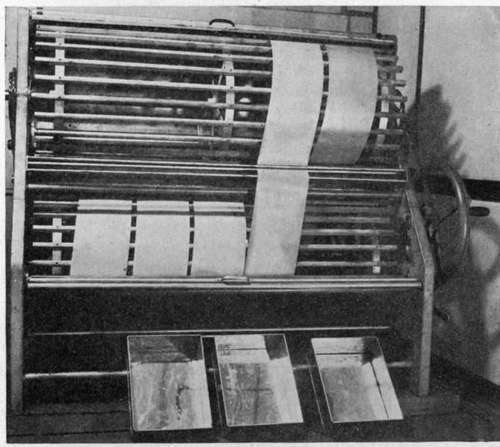Film Drying
Description
This section is from the book "Airplane Photography", by Herbert E. Ives. Also available from Amazon: Airplane photography.
Film Drying
Unlike the drying of plates, drying of film negatives is a very puzzling problem, and may be considered as the crux of the successful use of film in aerial cameras.
Apron and similar machines have very poor drying efficiency if the film is left in place, for not only the film but the apron or chain must be freed of water. This may be hastened, as in the G. E. M. machine, by blowing air through with fans, but even with their help drying a 35 foot film is a matter of two hours or more. Passing the film through wringers or a squeegee to remove excess water is a considerable aid; the film may either be re-wound on a dry reel, to be put in a forced draft of air, or may be hung up in short lengths or festooned, either method taking up a great deal of space. The use of alcohol is not advisable as it may abstract camphor from the celluloid and cause the film to become distorted.
The Eastman twin reel machine had an upper reel joined to the lower or developing reel, with a chain and sprockets, so that the upper reel revolved at the same time and rate of revolution as the lower, when the lower was being revolved at the gentle speed appropriate to the developing process. Fans blew a draft of air over the upper reel. This method necessitated over an hour for drying.
The Air Service model of film developing and drying machine (Fig. 117) introduces an essential modification in the drying scheme of the Eastman apparatus. The upper reel is quite independent of the lower reel and is revolved at a high rate of speed, so that a whirling action is introduced into the drying. Large rotating fans at the same time drive a considerable volume of air across the film surface, and the combination of the two agencies makes it possible to dry 35 feet of 18 X24 centimeter film in 20 to 30 minutes. This for large numbers of pictures makes the use of film even quicker than that of plates. The only practical drawback to the apparatus is its bulk, which calls for a separate room or trailer. This, however, seems to be inevitable in the use of large roll film.

Fig. 117. - U. S. Air Service film developing machine for film 24 centimeters wide.
Cut film can be dried with speed only if placed in a draft of warm air. Drying boxes, with a chute or chimney and with fans to drive the air through from an alcohol stove, will dry several dozen films in an hour. The films must not be closer together than about one inch, which makes the drying boxes rather cumbersome.
Continue to:
- prev: Plate Drying
- Table of Contents
- next: Marking Negatives
Tags
camera, lens, airplane, aerial, film, exposure, photography, maps, birdseye
